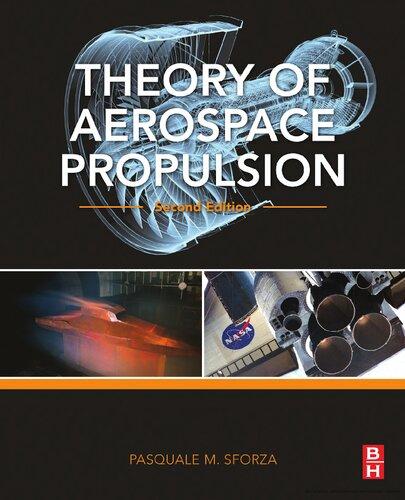
https://ebookmass.com/product/theory-of-aerospacepropulsion-2nd-edition-pasquale-m-sforza/

1st Edition Denis Constales
https://ebookmass.com/product/advanced-data-analysis-modelling-inchemical-engineering-1st-edition-denis-constales/
ebookmass.com



https://ebookmass.com/product/theory-of-aerospacepropulsion-2nd-edition-pasquale-m-sforza/

1st Edition Denis Constales
https://ebookmass.com/product/advanced-data-analysis-modelling-inchemical-engineering-1st-edition-denis-constales/
ebookmass.com

UniversityofFlorida
AMSTERDAM • BOSTON
HEIDELBERG • LONDON
NEW YORK • OXFORD • PARIS • SAN DIEGO
SAN FRANCISCO • SINGAPORE • SYDNEY • TOKYO
Butterworth-Heinemann is an imprint of Elsevier
AirbreathingEngines”andincludesasectiononinletsinsubsonicflightwhichdiscussesinletlip design,inletductfrictionlosses,andinletboundarylayerdiverters.Asectionontotalpressurerecovery withfrictionandshockwavelosseshasbeenadded.
Then Chapters7 and 8 aredevotedtothefundamentalsoftheturbomachineryrequiredforoperating airbreathingjetenginesthroughouttheflightrangeuptoandincludingsupersonicspeeds. Chapter7 developsthegasdynamicsandthermodynamicsofturbomachineryneededforanalyzingcentrifugal flowcompressorsandaxialflowcompressorsandturbines,includingvelocitydiagramsandthedevelopmentofperformancemapsfrombasicaerodynamicprinciples. Chapter8 delvesdeeperintothedetailsofflowswithinbladepassagesanddiscussestheimportantfactorsofboundarylayerseparationfor compressorsandheattransferforturbines.AnewsectiononcalculatingtheoptimumMachnumberat thecompressorfacehasbeenadded.
Integratingthevariouscomponentsdiscussedinthepreviousfivechaptersintoaworkingengineis thesubjectof Chapter9.Thedescriptionofdifferenttypesofturbojetandturbofanenginesnow includesadiscussiononthegearedturbofanengine.Thesimilarityvariablesimportantinthematching processarederivedanddetailedmatchinganalysesfortwobasicdesignapproachesarepresented. Issuesconcerninginlet-enginematching,thrustmonitoringandcontrolinflight,andfueldelivery systemsarediscussed.
Thelastchapterconcernedwithaircraftflightoperationsis Chapter10,whichcoverstheoperation ofpropellersandtheapplicationofthegasturbineenginetothem.Asectiondevotedtoasimpleanalysisfordeterminingstaticthrustandasectionongearedturbofansandopenrotorengineshavebeen addedalongwithanextensiveexampleproblemonturbopropperformance.
Chapters11 and 12 areconcernedwithliquidandsolidpropellantrocketengines,respectively, while Chapter13 isdevotedtospacepropulsionsystems. Chapter11 hasbeenexpandedandlargely rewrittenandasectiononpropellantdensityandspecificimpulsehasbeenadded.Thesectiononliquid propellantsnowincludesdetailedassessmentsoftheLH2-LOX,RP1-LOX,andtheLCH4/LOXpropellantcombinations.Thesectiononliquidpropellanttankandfeedsystemdesignhasbeenupdated andrewrittenandnowincludesdiscussionofliquidpropellanttankcharacteristics,analysis,andstructuraldesign,aswellasliquidpropellantfeedsystemsandturbopumpanalysisandsizingconsiderations. Chapter12 dealswithsolidpropellantrocketmotorsandincludesanewsectiononsolid propellantrocketmotorsizingandanassociatedworkedexample.
Chapter13 coverstheareaofspacepropulsionwithattentiongiventoelectricpropulsiontechniquesthatareofimportanceinsatelliteoperationsandspaceexplorationandnowincorporatesnuclear propulsionanditspossibleroleininterplanetarymissions.
Theeightappendicesdealwithimportantauxiliaryinformationforthemaintext: AppendixA presentsequationsforthecalculationofshockwavesandexpansionsandincludestablesandcharts. AppendixB givestablesforthepropertiesofhydrocarbonfuelcombustionproductsandincludesa narrativeexplainingthetablesandtheiruse. AppendixC givesabriefdiscussionofthephysicsof theearth’satmospherewithexpandedtablesofatmosphericpropertiesforgreaterutility.Thematerial in AppendicesDandE coversboostphaseandstagingofrocketsandsafety,reliability,andriskassessmentusingmaterialfromtheauthor’sbook MannedSpacecraftDesignPrinciples (Elsevier,2015). AppendixF dealswithaircraftperformanceintakeoffandcruiseusingmaterialfromtheauthor’sbook CommercialAirplaneDesignPrinciples (Elsevier,2014).Tablesofthermodynamicpropertiesofselectedchemicalspeciesappropriatetopropulsionapplicationsarepresentedin AppendixG while H providesalistingofusefulconstantsandconversionfactors.
TheoperationofaerospacepropulsionenginesrestsonthefoundationofNewton’slawsofmotion. Thesecondoftheselawsexplainsthatthechangeinmomentumofthefluidpassingthroughanengine isequaltotheforceactingonthefluid.Thethirdlawstatesthattheforceactingonthefluidexertsa reaction,anequalandoppositeforce,ontheboundariesseparatingthefluidandtheengine.Indeed, suchenginesareoftenreferredtoasreactionmotors.
Ingeneral,aerospacepropulsionenginesmaybethoughtofasidealizedflowmachinesinwhich fluidwithinthemachinehasworkand/orheataddedtoitpriortoitsexitfromthemachineasajet, therebyproducingthrustaccordingtothereactionprincipledescribedabove.Thefluidmayenterthe machinefromthesurroundingsormaybecarriedentirelywithinthemachinepriortobeingprocessed. Theformerenginesareusuallycalledairbreathingenginesandthelatter,rockets.Ofprimaryinterestis themagnitudeofthethrustproducedandtheefficiencywithwhichtheheatandpowerisusedingeneratingthrust.Inthischapterwewillclassifythedifferenttypesofaerospacepropulsionenginesand quantitativelydescribetheperformanceofeachbyapplyingthebasicintegralformsoftheconservationequationsofgasdynamics.
Themostefficientflowmachineisthepropeller,inwhichworkisdoneonthefluidpassingthrough it,butnoheatisadded.Thesourceofpowerisexternaltothepropelleritselfandmaybeaninternal combustionengine,agasturbine,orevenanelectricmotor.Inthischapterweshowthatthough efficient,thepropellerisspeed-limitedinthesensethatforagivenpowerinputthethrustdeveloped fallsoffwithincreasingspeed.
Conversely,theturbojet,ramjet,scramjet,andpulsejetareflowmachinesinwhichheatisaddedto theairstreamtakenaboard,butnonetworkisdoneonit.Theheatisaddedbyburningfuelinthat airstream.Thethrusttheydevelophasarelativelyweakdependenceonflightspeedmakingthemcapableofgoodperformanceatmuchhigherspeedsthanareachievablewithpropellers.However,they arelessefficientthanpropellersandtheirabilitytotravelathigher,evensupersonic,speedsisthus gainedatthecostofgreaterfuelconsumption.Therocket,avariantofthiscase,takesinnoambient
fluidbutinsteadcarriesonboardallthefluidtowhichheatisadded,againbycombustion,andsubsequentlyejectedasajet.Thethrustoftherocketisindependentoftheflightspeedbutthisadvantage ispaidforbyevenlowerefficiencythantheotherjetengines.Ontheotherhand,becauseallthenecessarypropellantiscarriedonboardtherocketisabletooperateinthevacuumofspace.
Ratherthanaddpoweraloneorheatalonetotheworkingfluidweshowthatbyaddingacombinationofpowerandheatwecanderivesomeofthespecialbenefitsofboththepropellerandtheturbojet.Thisistheturbofanenginewhichisthecommonjetpowerplantforbothcommercialandmilitary aircrafts.
Forspaceapplicationsweexaminemeansotherthanchemicalcombustiontoenergizeanonboard propellant.Nuclearthermalpropulsion(NTP)involvesheatingtheonboardpropellantbypassingit throughanuclearfissionreactor.Suchrocketscanprovidehighthrustwithhigherefficiencythana chemicalrocketbutposeradiationsafetyissues.Simpleelectricalresistanceheatingofapropellant isthebasisoftheresistojetwhilethearcjetusesanelectricdischargetoheatpropellant.Wealsoexaminethehighlyefficientbutlowthrustionrocketwhichgeneratesthrustbyelectrostaticacceleration ofionsandthemagnetoplasmadynamic(MPD)rocketwhichuseselectromagneticaccelerationtoaccelerateelectricdischarge-producedplasma.TheionandMPDrocketsexhibitveryhighefficiencybut arelimitedtorelativelylowthrustlevels.
Afterillustratingthedifferentenginetypeswhichusetheprincipleofjetpropulsion,attentionis focusedondetailsoftheforcefieldgeneratedbysuchenginesandthefactorsinfluencingtheproductionofthrust.
Aflowmachineisonewhichingestsastreamoffluid,processesitinternallyinsomefashion,andthen ejectstheprocessedfluidbackintotheambientsurroundings.Anidealizationofsuchageneralized flowmachineisschematicallydepictedin Fig.1.1.
FIG.1.1
Schematicdiagramofidealizedflowmachineandassociatedstreamtubecontrolvolume.
Inordertodevelopthebasicfeaturesofoperationoftheidealizedflowmachinewithoutintroducing unnecessaryalgebraiccomplexity,wemakethefollowingassumptions:
•Theflowthroughthestreamtubeenteringandleavingthemachineissteadyandquasi-onedimensional.Masscannotcrossthestreamtubesurfaces.

Propeller blade
Motor

FIG.1.2
Generalarrangementofapropellerdrivenbyanexternalpowersourcesuchasaninternalcombustionorgas turbineengineoranelectricmotor.Station1isintheplaneofrotationofthepropellerblades.
tothetemperaturebythespecificheatatconstantpressure cp ,theenthalpydifference he h 0 ¼ c p( Te T0 ) 0which,whenusingEq. (1.2),transformsEq. (1.4) into
Subsequentlyitwillbeusefultothinkofthispowerimpartedtotheflowtobethesumofausefulpart thatsustainsthemotionandanotherpartthataccountsforlosses.Thereforewewrite
Thenthelosstermis
FromEq. (1.5) weseethatthepowersuppliedtothefluidisapproximatelyequaltotheproductofthe forceonthefluidandtheaverageofthevelocitiesenteringandleavingthemachine.In Chapter10 we willprovethattheaveragevelocityisthevelocityattheplaneofrotationofthepropeller(station1in Fig.1.2)sothatthemassflow
Whentheairisacceleratedbythepropellerfrom V0 intheundisturbedfreestreamtoahighervalue Ve fardownstreamfromthepropellerwhere pe recoversto p0,Eq. (1.2) showsthattheforceontheair F > 0.Furthermore,Eq. (1.5) showsthat P > 0andthereforeworkisdoneontheairbythepropeller. Inadditiontothepropellerthatweseeongeneralaviationandregionaltransportaircraft,thisisalsothe caseoftheturbofanandtheaxialflowcompressor,bothfoundoncommercialandmilitaryjetswhere thedevicedoesworkonthefluidandproducesaforceonthefluidinthesamesenseastheentering velocity.Notethatthismeansthatthereactionforceofthefluidonthemachineisintheoppositesense, thatis,a thrust isdeveloped.Propellersandcompressorswillbediscussedindetailin Chapters10 and 7,respectively.
Iftheflowmachinedeceleratesthefluidfrom V0 intheundisturbedfreestreamtoalowervalue Ve far downstreamfromthedevicewhere pe recoversto p0,Eqs. (1.2),(1.5) showthattheforceonthefluid F < 0andthepower P < 0,sothatworkisdonebythefluid.Thisisthecaseoftheaxialflowturbine whichisusedinjetenginestodrivethecompressor.Thisisalsothecaseofwindturbine,whereworkis extractedfromthewindandusedtodriveanelectricgenerator.Intheseflowmachinesthefluidexperiencesaretardingforce,thatis,theforceonthefluidisintheoppositesensetothatoftheincoming velocity.Thereactionforceonthemachineisthereforeinthesamesenseastheenteringvelocityandis thereforea drag force.
Foraconstantvalueofpoweraddedtothefluidequation (1.5) showsthatthethrustforcedeveloped dropsoffwithflightspeed:
Thevariationofthethrust-to-powerratioofanaircraftpropellerasafunctionofflightspeedforvarious ratioof Ve/V0 isillustratedin Fig.1.3
Itisclearthattheconversionofpowerappliedtothefluidintothrustdropsoffrapidlywithflight speedandthatacceleratingtheflowtohighervaluesof Ve yieldsdiminishingreturnsinthrustfora fixedpowerinput.FromthisobservationandEq. (1.2) weseethathighpropellerthrustisbestaccomplishedbyacceleratingalargemassflowofairthroughasmallvelocityincrease.Itisfurtherrecognizedfrom Fig.1.3 thatpropellerthrustishighestatlowspeedsandthisprovidesimprovedtake-off accelerationandreducedrunwaylengths.Becauseoftherapiddropin F/P asafunctionofflightspeed wealsoseethatthemaximumflightspeedofapropeller-drivenaircraftislimitedbythepower available.
Wemayrearrangethisequationanduseourresult F ¼
toobtain
TheMustang’spropellerdiameteris3.4m,sothearea A1 ¼ 9.07m2 andwesolvetheaboveequationto find Ve/V0 ¼ 1.0236.Thusweseethatthelargemassflowofairpassingthroughthepropellerisacceleratedonlyaverysmallamounttoproduceasubstantialthrust.UsingthisratioinEq. (1.10) wemay calculatetheflightvelocitytobe V0 ¼ 184.1m/s(411mph).UsingEq. (1.9) tocalculatethepropulsive efficiencywefind
Althoughthepropulsiveefficiencyishigh,Eq. (1.10) makesitquiteclearthattheflightspeedofa propeller-drivenaircraftislimitedbecause V0 P1=3 s sothatincreasingpowerprovidescontinually diminishingreturns,ascanbeseenfromthederivative dV0 =dPs P 2=3 s .Notethatthemassconservationequation—Eq. (1.7)—withtheincompressibleflowassumption(ρ0 ¼ ρ1 ¼ ρe)showsthat A0V0 ¼ A1Vavg ¼ AeVe.Thusthestreamtubearea A0 capturedbythepropellerisslightlylargerthan thepropellersweptarea A1.Inthesamefashionthedownstreamarea Ae isslightlysmallerthanthe propellersweptarea A1
Nowwetaketheoppositetackandexaminetheeffectofnonetpowerbeingtransferredintooroutof thefluidpassingthroughtheflowmachine.ThenEq. (1.3) with P ¼ 0readsasfollows:
NotethatasinEq. (1.5) wemaywritethekineticenergyterminEq. (1.11) as
SubstitutingEq. (1.12) intoEq. (1.11) andsolvingforthethrustyields
Ifsufficientheatisaddedtothefluidsuchthat Q > 0andthat Q > (he h0),Eq. (1.13) showsthat F > 0 andthereforethrustisproducedontheflowmachine.Thisisthebasisofoperationofthesimplejet engine.Thegeneralinternalconfigurationofthepracticaljetengineisdependentupontheflightspeed. Theinletcapturestheairtobeprocessedbytheflowmachine.Forflightintherangeof0 < M0 < 3the
jetenginerequiresacompressortoincreasethepressureoftheincomingairbeforefuelisaddedand burned,particularlyinthelowendofthespeedrange.Theheatedcombustionproductsarethenacceleratedbyanozzletoproducethrust.Thecompressormustbedrivenbyashaftpowersourceandthis ismosteffectivelysuppliedbycouplingagasturbinetoit.Thegasturbineextractsjustenough powerfromthehotcombustiongasestodrivethecompressorsothatthenetpowerintothefluid P ¼ 0.Rotatingcompressorsandturbinesaregenerallycalledturbomachines.Suchanarrangement iscalledaturbojetengineandisschematicallyillustratedin Fig.1.6.Thefifthbasicassumptionstated in Section1.2 wasthatanymassinjectedintoorextractedfromthefluidstreamwithintheflowmachineisnegligiblecomparedtothemassflowenteringtheflowmachine.Inthecaseoffuelinjection themixtureratioofairtohydrocarbonfuellikekeroseneforcompletecombustionisabout15.This resultsintemperaturesmuchtoohighforpracticalenginestructuressothatexcessairisaddedbringing theair-to-fuelratiotoabout50(2%oftheairflow)whichcertainlyisinkeepingwiththeideaof theaddedfuelmassflowbeinginsignificantcomparedtotheoverallairflow.Interestingly,practical considerationsrequirethataboutanequivalentmassflowofairbebledfromthecompressortoserve variouspneumaticfunctionsonanaircraft.Thustheneteffectisthatthemassflowthroughtheengine isquiteconstant.
ForsupersonicflightintheMachnumberrangeof3 < M0 < 5therampressureproducedbythe inletinslowingdowntheincomingairtosubsonicspeedsobviatestheneedforthecompressorand thereforeitsdrivingturbine.Asaconsequence,apracticaljetengineforthisflightregimeiscalleda ramjetanditsconfigurationisverysimple,asshownin Fig.1.7,wheretheturbomachinerynolonger appears.Thissimplicitycomesatapricehowever,becausetheramjetcannotoperateeffectivelyat lowerspeeds.Inparticular,itgeneratesnothrustatzeroflightspeedsothatitcannotprovidethrustfor takeoff.Theramjetmustbeacceleratedtonearsonicorsupersonicspeedsbysomeotherpropulsive meansbeforeitcanproduceenoughthrusttosustainflightofthevehicleitpowers.Itisthereforeoften usedtopowermissileslaunchedfromanaircraftinhigh-speedflightorbyarocketbooster.
FIG.1.6
Thisschematicdiagramofatypicalturbojetengineshowstherequiredturbomachinerycomponentsanda commonstationnumberingscheme.Thecombustorburnstheinjectedfuelsupplyingheattotheflowpassing throughtheturbojet.
Then,identifying V0/Vavg asthepropulsiveefficiency ηp definedinEq. (1.8),theoverallefficiencyis expressedastheproductofthepropulsiveandthermalefficiencies
Thethermalefficiencyaccountsforthefactthatnotalltheheataddedisconvertedtouseableheat power,sincesomeisrejectedasincreasedinternalenergyintheexhaustgases.Thepropulsiveefficiencyaccountsforthefactthattheincreasedkineticenergyoftheexhaustjetrepresentsalossinmechanicalpowertomaintainflightatthespeed V0.Inajetenginethesetwoefficienciesgenerallydrive indifferentdirections,withthehigherexhaustvelocitiessustainableathighthermalefficiencyleading tolowerpropulsiveefficienciesatagivenflightspeed.Whereasapropeller-drivenaircraftwillcruise at V0/Ve 1,asubsonicturbojet-poweredaircraftismorelikelytocruiseat V0/Ve 0.6.From Fig.1.4 weseethatthepropeller-drivenaircrafthasapropulsiveefficiency ηp 1,andthevalueforthe turbojet-poweredaircraftis ηp ¼ 0.7.
Theheataddedtotheflowisdirectlyproportionaltotherateoffuelconsumption _ mf andtothespecific energycontentofthefuel Qf asexpressedby
Theconstantofproportionalityiscalledtheburnerefficiency ηb sothattherateofheatadditionthrough combustionbecomes
Theburnerefficiency ηb representstheratiooftheheatreleaseactuallytransferredtotheflowingcombustiongasestothetotalheatreleasepossible.Eq. (1.18) isbasedontheassumptionthattherateofheat additionarisesfromtheenergyreleasedinthechemicalconversionofthefuelascharacterizedby Qf, whichiscalledtheheatingvalueofthefuelperunitmassorthespecificenergyofthefuel.Thecharacteristicsoffuelsusedinaerospacepropulsionapplicationsarediscussedindetailin Section1.8
Acommonmeasureoffuelefficiencyforjetenginesisthespecificfuelconsumption cj,whichis definedintheEnglishsystemofunitsastheratioofthefuelmassflowtothethrustforceproducedand reportedaspoundsmassoffuelconsumedperhourperpoundforceofthrust,lbm/lbfh.Forconvenience,andinapplicationswhereitshouldnotcauseconfusion,wewillsimplydenotepoundsforce aslb,thatis,lb ¼ lbf.IntheSIsystemofunitsthespecificfuelconsumption cj isstilltheratioof themassflowoffuelconsumedtothethrustforceproduced,buthastheunitsofkg/hN.Anominal valueforturbojetsis cj ¼ 1.0lbm/h/lbfwhich,inSIunits,istransformedto cj ¼ 0.102kg/h/N.Itmustbe emphasizedthatcarebetakentoaccountproperlyfortheunits,particularlysincebothsystemsofunits areinroutineuseintheaerospaceindustry.
Recallthatthesetofassumptionsmadeattheoutsetincludedtherequirementthatthemassof fluid,inthiscasefuel,addedtothegeneralstreamenteringtheflowmachineisnegligible,thatis, _ mf ≪ _ m0 ¼ _ m Asdiscussedpreviouslyandaswillbeshownin Chapter4,practicalfuelmassflows aremuchsmallerthantheairmassflowrate,sonolossingeneralityisincurredherebyignoring
theaddedfuelmassflow.However,wecanaccountforthefuelconsumedbycombiningEqs. (1.15), (1.18) todefinethemass-basedspecificfuelconsumptionintheformshownbelow:
Foratypicalhydrocarbonjetfuelwith Qf ¼ 43,400kJ/kg(see Table1.1)andvelocitymeasuredinm/s, thespecificfuelconsumptioninkilogramsoffuelperhour(3600s ¼ 1h)perNewtonofthrust becomes
Theunitsshownfor cj,kg/Nh,isessentiallyanacceleration(kg/N)dividedbyatime(h)andisthereforeaninversevelocity.IntheEnglishsystem,thesamehydrocarbonjetfuelhas Qf ¼ 18,660Btu/lbm andwithvelocitymeasuredinft/s,wewilldenotethespecificfuelconsumptioninpounds(mass)of fuelperhourperpoundofthrustasfollows:
Burnerefficiencyisgenerallyquitehigh,aswillbeseenin Chapter4,andforthepresentpurposesit maybetakenas ηb ¼ 0.95.However,thethermalefficiencybearsabitmoreconsideration.Expanding Eq. (1.16) leadstothefollowingrepresentationofthermalefficiency:
Undertypicalsubsonicjetaircraftflightconditionsinthestratospheretheatmospherictemperature T0 ¼ 216K, cp,0 ¼ 1.04kJ/kgK,andthefuel-to-airratio _ m
= _ mo 0 02.Withaburnerefficiency
ηb ¼ 0.95,andonceagainusing Qf ¼ 43.4MJ/kgthethermalefficiencybecomes
Theratioofstatictostagnationtemperatureintheexhaust,assumingthatforthehotexhaustgases(see TableB.2)theratioofspecificheats γ e 4/3,isgivenby
ForasubsonicjetaircrafttheexhaustMachnumber Me 1sothatanominalvalueofthetemperature ratiois Te/Tt,e ¼ 0.857.Atypicaljetexhauststagnationtemperature(seeTable9.1)is Tt,e ¼ 800Kmaking Te ¼ 686Kwiththecorrespondingspecificheatvalue(seeTableB.2)of cp,e ¼ 1.1kJ/kgK.Then thethermalefficiencyis
824:6kJ=kg ¼ 0:357
thespecificfuelconsumptioninsupersonicafterburningmodemaybeasmuchasfivetimeslargerthan inthesubsonicturbojet.Carefuldesignoftheexhaustnozzlecanimprovethethermalefficiencysubstantiallysothattheincreaseinspecificfuelconsumptioninafterburnermodemaybereducedtoabout twicethevaluewithoutafterburner.
FIG.1.11
Turbojetenginewithanafterburnersectionintroducedbetweentheturbineandthenozzle.
ThePratt&WhitneyJ57turbojetshownin Fig.1.12 wasthefirstjetenginetodevelop45kN (10,000lb)thrustandpoweredtheNorthAmericanF-100SuperSabrejetfightertosupersonic flightspeed.

FIG.1.12
ThePratt&WhitneyJ57turbojetwasthefirstjetenginetodevelop45kN(10,000lb)ofthrust.